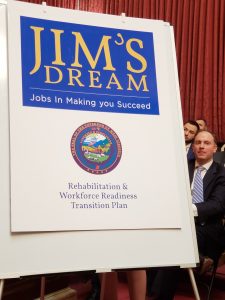CHARLESTON – Gov. Jim Justice shed more light on his Jim’s Dream drug abuse program and unveiled a Charleston-area program to keep unused opioids out of the wrong hands during a Thursday afternoon press conference.

Jim’s Dream is his four-part, $45 million plan to address the state’s opiod problem, which he briefly introduced during his State of the State Address.
“I’ve not had a time at bat. I’ve not really had the ball,” he said Thursday. “Somebody has got to really take ownership that has the tenacity and the vision that I may very well have.”
The four parts of his dream are:
— Prevention at an early age. He wants to put some money form the Fiscal year 2020 budget aside to do that if it’s possible.
 — Treatment. “We need to accept people for free.”
— Treatment. “We need to accept people for free.”
— Job training. He wants to include those who aren’t addicted or recovering, but want job skills. But all who complete the training must pass a drug test to get certified.
— Expungement of misdemeanor drug charges for those who complete treatment and training.
Justice said he told state schools Superintendent Steve Paine that he wants to put 1,000 people through training every 90 days. He admits his sights are set high, but he also wants practical, real-world training. “You have to train these people to do something that they can genuinely do.”
 Jim’s Dream will take $20 million from available surplus funds to buy training equipment and upgrade training centers, Justice said. That’s one-time spending.
Jim’s Dream will take $20 million from available surplus funds to buy training equipment and upgrade training centers, Justice said. That’s one-time spending.
Another $25 million will come from the FY 2020 budget: $5 million for prevention, $10 million from the Department of Health and Human Resources for treatment, and $10 million for staffing and for equipment maintenance and replacement.
The state Budget Office told members of Senate Finance during a meeting later in the day that it’s not clear at this time what future costs might be.
Justice then turned the floor over to Katherine Wiseman, national vice president of UnitedHealthcare, and Kane Maiers, area medical director for MedExpress, to explain the drug disposal program.
Wiseman noted that 60 percent of opioids dispensed go unused and can be diverted to people who could abuse them.
So UnitedHealthcare is giving the Charleston-area Recovery Point recovery center 7,000 drug Deterra deactivation and disposal pouches to distribute for free around the community.
Maiers demonstrated how the bags work. The patient tears open the bag, puts in the pills or patches, adds some water and closes the bag. The pouch contains active carbon which renders all the compounds in the dissolved pills inactive. The pouch can then be tossed in the trash.
While the program is targeting opioids, Maiers noted that the pouches can be used for any drugs, including antibiotics which contribute to bacterial drug-resistance when they get into water systems.
The U.S. FDA’s drug disposal guidelines allow oxycodone, hydrocodone and fentanyl to be flushed down toilets. Asked about this, Maiers said this provides an extra safeguard because it deactivates all the compounds in the pills.
TWITTER @dbeardtdp Email David Beard at dbeard@dominionpost.com




